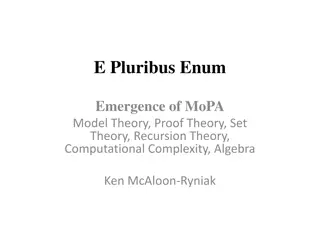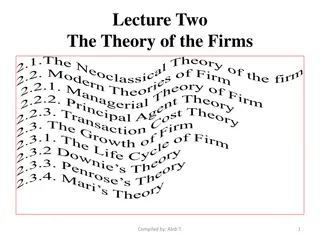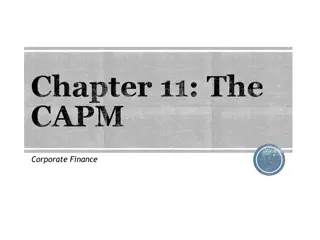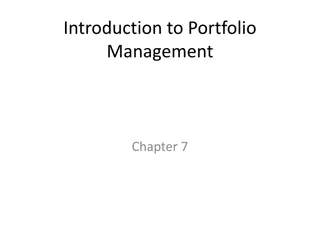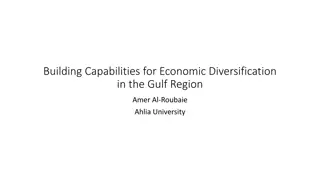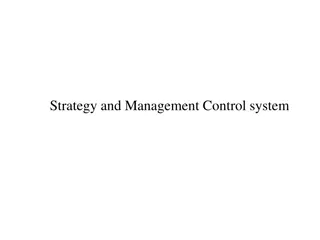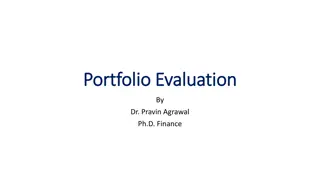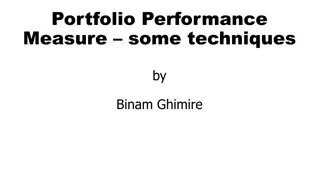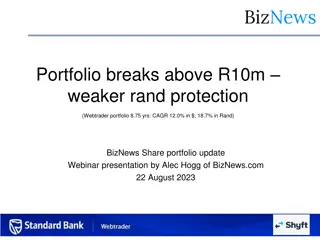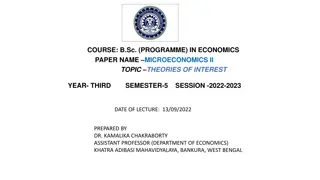Modern Portfolio Theory and Diversification
Harry Markowitz's Modern Portfolio Theory emphasizes forming diversified portfolios to maximize returns while minimizing risks. It involves analyzing securities' expected returns, risks, and correlations. Diversification is key in combining securities that move differently over time to reduce overall portfolio risk. Mental accounting and perceptions of risk can influence investment decisions. An example analyzes the risk impact of adding various investments to an existing portfolio.
Download Presentation

Please find below an Image/Link to download the presentation.
The content on the website is provided AS IS for your information and personal use only. It may not be sold, licensed, or shared on other websites without obtaining consent from the author.If you encounter any issues during the download, it is possible that the publisher has removed the file from their server.
You are allowed to download the files provided on this website for personal or commercial use, subject to the condition that they are used lawfully. All files are the property of their respective owners.
The content on the website is provided AS IS for your information and personal use only. It may not be sold, licensed, or shared on other websites without obtaining consent from the author.
E N D
Presentation Transcript
Chapter 7 Forming Portfolios
Fifty years ago, Harry Markowitz developed what is now called Modern Portfolio Theory Nobel Prize winning theory Investors should put all of their investments as one integrated portfolio. The portfolio should be the securities that combine to give the highest return for the desired level of risk. 2
Modern Portfolio Theory The important characteristics of a security Expected return Risk (standard deviation of return) Correlation with other securities 3
Diversification: Combine securities that behave differently over time. Stocks A and B in the next figure have approximately the same return and variation in stock price over time. However, notice that when stock A is advancing, stock B is often declining. Because stocks A and B frequently move in opposite directions, buying both stocks creates a portfolio with reduced risk. 4
Mental Accounting Each decision or action is placed in a separate account The interaction between mental accounts is usually ignored This makes the use of correlation and modern portfolio theory difficult 6
Perceptions of Risk Because of mental accounting Investors tend to ignore the interact between securities Investors only consider expected return and standard deviation in the investment decision Consider the following example
Example You have a diversified portfolio of large domestic and international stocks with some fixed income securities. You are examining the following investments: commodities, corporate bonds (high grade), emerging markets stocks, Europe & East Asian stocks, high-yield bonds, real estate, Russell 2000 Growth Index, small-cap stocks, Treasury Bills 8
How does the addition of each investment change the risk of the existing portfolio? Rank the securities in order of how much risk they would add to the portfolio. The number 1 indicates the lowest level of risk, while the number 9 indicates the highest risk. Three groups were asked this question: 45 undergraduate students in an investments course. 27 MBA students in an investments course. 16 participants in an investment club. 9
Investors View of Risk Contribution to Portfolio Note that all three groups ranked the change in risk very similarly. Also note that the rankings are very similar to the ranking of each security by its standard deviation of returns (far right figure) People rank how the security changes the portfolio risk by their perception of the actual risk of the security 11
Investors View of Risk Contribution to Portfolio However, the change in risk of the portfolio is more a function of how the security is correlated with the existing portfolio. Less a function of the total risk of the security. The most important factor is ignored because of mental accounting. Consider how these securities co-vary with the portfolio. 12
Actual Risk Impact The figures show that actual risk impact on the portfolio is better measured using each security s beta. Beta tells us the securities systematic risk, not total risk. Note that some securities with high total risk have low betas (real estate, commodities, emerging markets, etc.) 15
An Application Politicians often specify what the public pension plans can invest in. Public pension funds are the money set aside to pay for the retirement of state and local employees (teachers, police, etc.) Professional money mangers are hired to invest the money 16
Inhibiting Efficient Portfolios Government Finance Officers Association 1999 survey 211 pension plans responded Consider risk contribution demonstrated in the last figure 14 plans could not invest in real estate 8 plans could not invest in corporate bonds 19 plans could not invest in foreign securities 3 plans could not invest in U.S. stocks 17
Behavioral Portfolios Investors rarely consider the interaction between securities when picking stocks Because of Mental Accounting Thinking of all your securities as one portfolio is difficult Modern portfolio theory is therefore not utilized 18
Behavioral Portfolios People pick investments based on how the it fits the characteristics they are looking for: total risk return income/capital appreciation liquidity 19
Picking InvestmentsBuffet Style! Investors rarely consider the interaction between securities when picking stocks. People pick investments to meet specific needs. This money is in the bank for safety in case I lose my job. This money is invested in stocks because it is for retirement in 20 years. This money is in high-risk investments so that I might be lucky and strike it rich! Think of an investor s portfolio as building a pyramid 20
Behavioral Portfolio Theory Whereas investors implement the mean-variance efficient frontier in MPT, they utilize a behavioral- wants frontier. When people view their investment portfolio, they don t just see expected return and risks, they also see expressive and emotional benefits House they are saving for, their children in college, a comfortable retirement, etc. The portfolio is a means to attaining their wants The difference between implementing a MPT portfolio and a BPT portfolio like eating the diet that is optimized for maximum nutrition at the least cost (the MPT) versus eating a diet that includes the expressive and emotional benefits of taste, variety, and cultural tradition (the BPT). 21
Behavioral Portfolios People do not think of their portfolio like modern portfolio theory. Instead, we think of it as a pyramid of assets held to meet a hierarchy of goals. 22
The Portfolio The portfolio that investors end up with is a function of how many of these mental accounting needs they have. It is unlikely that a portfolio created this way would provide the highest return for the level of risk taken! 23
Characteristics of Behavioral Portfolios A person s portfolio is a refection of the person s wants, needs, desires, and fears. Thus, a behavioral portfolio includes the following characteristics: Built on wants, like social status, avoiding poverty, and a comfortable retirement. Satisfies expressive and emotional benefits like avoiding socially irresponsible investments and conforming to social network s expectations. Circumstances matter so the portfolio will change and adapt as wants and expressive benefits change. Includes behavioral errors and cognitive biases that guide investors away from optimising their wants frontier. Risk is assessed as the likelihood of falling short of attaining the wants and expressive benefits. Portfolios are structured in layers like a pyramid. 24 Continued
Household Portfolios Consistent with people matching investment assets to separate goals Each household exhibits both risk-aversion and risk-seeking behavior at the same time They invest both in diversified portfolios like mutual funds and in undiversified stock portfolios with few individual stocks Some investors buy safe money market funds and dabble in penny stocks Note that individual investors are unlikely to have private information about these stock and thus are sensation seeking 25 Continued
Household Portfolios Households with between $100,000 and $1 million in financial asset wealth 10 15 % of these households own no stocks (either directly or indirectly through funds) Of those with stock market ownership, the median household has 15% of its financial wealth in a stock portfolio consisting of only four stocks! The median household also has 49% of its financial wealth in diversified stock portfolios through mutual funds and pension plans 26 Valery Polkovnichenko, Household Portfolio Diversification: A Case for Rank-Dependent Preferences, Review of Financial Studies 18(2005): 1467 1500
Preferred Risk Habitat People try to match their level of risk aversion to their investments They do not appear to match their preferred risk level to the risk of their total portfolio They tend to use their desired risk level to pick each of the individual components that make up the portfolio 27
Preferred Risk Habitat Dan Dorn and Gur Huberman s study of 20,000 German brokerage accounts They pick a preferred risk habitat and then pick from the stocks in that habitat They replace a stock in their portfolio with a new stock that is in the same risk habitat Those investors who are most prone to specializing in a risk habitat underperform other investors because they take too much diversifiable risk 28 Daniel Dorn and Gur Huberman, Preferred Risk Habitat of Individual Investors, Journal of Financial Economics 97(2010): 155 173.
Nave Diversification When faced with a few investment choices, investors often allocate an even amount to each the 1/n heuristic. Can skew asset allocation if more of one asset class is offered Occurs even if one investment is all-encompassing (like target year funds) or highly concentrated (like the employer s stock) When faced with a lot of investment choices, investors pick a subset and then tend to implement the 1/n rule to those (called the conditional 1/n heuristic) - Experience tends to reduce the 1/n heuristic 29
Summary The tools of traditional finance, like modern portfolio theory, can help investors establish efficient portfolios to maximize their wealth with acceptable levels of risk However, mental accounting makes it difficult to implement these tools Instead, investors use mental accounting to match different investing goals to different asset allocations. This often leads to investors diversifying their portfolios by goal rather than in total. They ignore their diversification characteristics. Investors also implement na ve diversification techniques. 30






